Miche using a Stiff Levain and Gilchesters Organic Farmhouse Flour
Material | Recipe [grams] |
1. Leaven Build One | Thursday 18:00 |
Leaven | 80 |
White Bread Flour [Marriage’s Organic Strong White Flour] | 100 |
Water | 60 |
TOTAL | 240 |
|
|
2. Leaven Build Two | Thursday 23:00 Refrigerated @02:30 Fri |
Leaven from above | 240 |
White Bread Flour | 150 |
Water | 90 |
TOTAL | 480 |
Material | Formula [% of flour] | Recipe [grams] |
Leaven from above | Flour: 27 + Water: 16. Total: 43 | 240 + 144 384 |
Gilchesters Organic Farmhouse Flour | 73 | 660 |
Salt | 1.78 | 16 |
Water | 62 | 558 |
TOTAL | 179.78 | 1618 |
Overall Pre-fermented Flour | 27 | - |
Overall Hydration | 78 | - |
Flour Mix | 27% White Bread Flour 73% High Extraction Flour | - |
Method:
- Combine the flour for the final dough with the water and autolyse refrigerated overnight, Thursday.
- Friday morning; combine the autolyse with the leaven and work up the dough for 3 minutes. Add the salt and develop a further 3 minutes. Rest for 15 minutes. Develop a further 5 minutes.
- Bulk proof for 2 hours. Stretch & Fold every 20 minutes.
- Mould gently round and place upside down in a prepared Banneton
- Final proof in Bannetons for 2 hours
- Bake Profile for the one large loaf: I loaded the loaf, once tipped out and cut, into an oven at 250°C and utilised steam. After 15 minutes I turned the heat down to 220°C. After another 20 minutes I turned the heat down to 200°C and baked the loaf out a further 20 minutes. Then I left the loaf in the oven, switched off, with the door propped open. Finally I cooled the loaf on wires before the inevitable photo shoot.
Notes:
- Where the previous loaves using this cold process took 7 hours to prove, this loaf was ready in just 4 hours. Here are the reasons why:
- The hot weather has returned and our kitchen has maintained a steady 28°C all daylong in the sunshine: FAB!
- The high hydration of the dough
- The dough contains a lot of high extraction flour with considerable increase in enzymatic activity
- There is slightly more pre-fermented flour in this formula, and my leaven has been enjoying a lot of activity, and, therefore big feedings, of late
- Photographs: lots of them, and I am really pleased with these. What a difference it makes to be able to take snapshots outside in the sun!
- The bread; I am soo pleased with this too! The flavour is quite lovely. A hint of sourness, not too obvious. Lots of caramel notes from that dark crust. The interior is chewy and robust, but just open enough to prevent it being too heavy.
- So this is it: how to make a Miche using genuine High Extraction flour! AND, the flour comes from Organic Sativa Wheat, traditional tall stem variety, utterly untampered with by any genetic fiend, and grown on a family farm in Northumberland UK. Stoneground on the only newly-installed traditional milling system to be opened in Northumberland in over 150 years. Thank you Andrew Wilkinson! High protein for sure, but put this side-by-side with any industrial bread flour and there is such a contrast in gluten potential.
- I suppose I could look at feeding the leaven with the Gilchesters Pizza/Ciabatta flour to create a 100% local flour loaf. But the leaven would be so much less tolerant, and I am not sure I’d feel confident about being able to keep all the enzyme activity in control.
Very best wishes from a Happy Bunny!
Andy
- ananda's Blog
- Log in or register to post comments

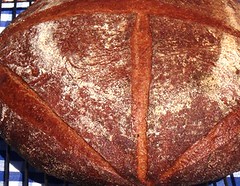

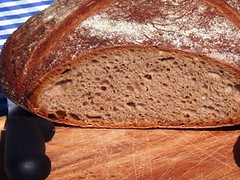


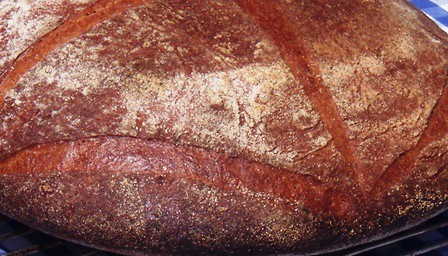


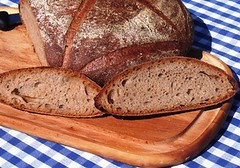


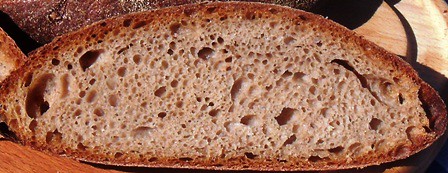

That's a really wonderful looking miche - wow!
Hi Sali,
I'm looking for general concepts you folks coming on the Course want to pursue.
Richard has probably been in contact about that. Either let him know, or pm me.
Many thanks
Andy
I'll PM you - thanks!
A regular on TFL was asking me why I used the long "autolsye", as opposed to Reinhart's method of using a soaker, containing salt.
I've followed quite a bit of what Peter Reinhart has written, and found his work on Wholegrain breads particularly thought provoking. I used the "epoxy" method for a good while, and noted how the "mash" bread harkened back to my early days in fermentation when I was making real beer as a student.
I liked this, and learnt a great deal about controlling enzymes. I believe that was what this particular book was really trying to focus on. We could create great wholegrain breads if we found a way to slow down all those enzymatic reactions which get such a kickstart when we use mineral-rich wholemeals as opposed to refined white flours.
Actually, that has been the main journey here, for me, in learning how to make a really high quality miche with the local flour milled to high extraction.
The overnight autolyse is no different to the soaker in many ways. Whilst enzyme reactions still take place down to -2*C, the lower temperatures still slow them down. So what am I trying to achieve with the autolyse?
I'm trying to add a different dimension to the one first adopted by Prof. Calvel in his "Improved" mixing to try and combat the intensive mixing process which came to dominate French [and many others, of course] industrial baking in the post war era. He was trying to speed up these enzymatic reactions. He was also using flour with a much lower ash content to the flour I have in this formula. So, the cold autolyse is essential.
And, yes, I could have added salt to this to slow down the enzyme reactions more effectively. Why not? The answer involves looking at the levels of hydration and the competition for water. Salt being one of the more hygroscopic substances used in baking, will always win hands down in the competition for water in the battle with flour. But, I have a mineral-rich, but low gluten flour, that needs properly hydrating, but does not really have the potential structure to take up and hold that water very easily. The long and cold autolyse allows plenty time for all parts of the flour to slowly take up as much water as possible, and still then allow me to produce a stronger and sturdier dough. I am particularly pleased with achieving 78% hydration in this dough. I know an authentic miche requires high hydration, and I appreciate a high extraction flour likes plenty of water. This was my key technique to achieve these things.
So, that's the trick here. I've been convined about this aspect of "autolyse" for some time. I even use it as a technique in the class with lower levels baking students making wholemeal breads for the first time. They are instructed to carry out just a half hour autolyse for wholemeal dough to be used to make tinned bread. Hydration is set at 72%, and the dough is very wet after just 3 minutes slow mixing at the point when the mixer is turned off, and the autolyse commences. The story is, of course, very different when all the remaining ingredients have been added and the mixing cycle complete.
Andy
Andy,
Thanks for explaining the difference between your autolyse and PR's. Makes sense and now that I am beginning to see a bigger picture here I will have to give your method a go and see if I can see a difference in the doughs I work with but I am thinking all my flours are strong so it might not be as essential in my process.....but summer weather is upon us here in Colorado so my soakers might end up in the refrigerator anyway :-)
Amazing how one things just leads to something else and then on to something else....an unraveling road for us to travel. I love it!
Bread had to get 'bad' (intensive mixing in post war era) before it could get good again and now it is moving beyond good into the realm of excellence :-).
Thanks for sharing all of you knowledge here - sure takes a lot of time off of my learning curve!
Take Care,
Janet
Hi Janet,
Glad this is helpful to you; there are different soaking methos available.
I like to use the "boil-up" or "zavarka" technique from time to time, creating chewy texture to the bread by gelatinising the starch and de-naturing the proteins. Good technique for getting more water still into the dough.
Very interesting comment you make about bread having to get 'bad'. Most of it in the UK remains woeful to this day, I'm afraid. But, yes, there is an increase in those of us searching for alternatives. And the obvious way to find, is to make your own, of course!
Best wishes
Andy
Andy,
If there is one thing I have learned in life it is that change takes a LONG time but what is interesting is that change for the worse seems to happen a much more rapid rate if $$$$$ is involved.
The road less traveled IS less traveled but there is company and having the internet to connect those of us on our obscure 'roads' makes a huge difference in the sharing of new ideas.....'Fringe dwellers' now have an international network from which to draw and knowing I am not alone in my pursuits makes a huge difference in my outlook!
Because of this vast network I was able to do something yesterday that I NEVER would have attempted to do before. I baked 2 loaves of bread using a Pullman Pan! I didn't even know such pans existed before I started reading threads here and seeing the loaves in pictures....Thanks to Akiko and txfarmer ;^).
Take Care,
Janet
This is where I have always found myself too Janet.
And happy about that with knowing conviction.
Did you try out 4-piecing when moulding your dough for the Pullman Pan?
All good wishes
Andy
Andy,
I used 9x4 pans so I 3-pieced.
Fun to do but I have to work at getting all 3 pieces uniform heights. I did weigh out the dough pieces but must have rolled with different tension. I gave the loaves to 2 friends and they had never seen anything like them before either. Didn't notice the uneven heights - just loved the bread!
Take Care,
Janet
Andy,
I think it was in the panning too. I didn't use the lids because I wanted it to look like Akiko and txfarmer's loaves. I like the 'mountain' effect :-)
Practice indeed! When I was younger I didn't like practicing anything. This kind of practicing is fun :-)
Thanks for the encouragement.
Take Care,
Janet
Hi Andy,
That is a very nice loaf, Andy. Especially crumb looks very tasty.
I like the method of long autolyze in the refrigerator, which is what I want to try. One of my friends told me of some good organic floor around my area. So, I better look into some different kind of flour, too.
Best wishes,
Akiko
I'm sure it's not so easy at all for you to find any flour that is really "different" Akiko.
Please tell us more when you start baking with the flour you mention.
Thank you as always for your kind words
Best wishes
Andy
Thanks for sharing the rationale for your methodology.
The long cold autolyse is also used in Gosselin's baguettes which have produced the best baguette flavor of any formula for me. My tasting of Gosselin's Baguette Tradition in Paris last week was inspiring. In fact, I have dough for a sourdough version of the Gosselin baguettes in the fridge right now, and I'll be baking them this evening.
Regards,
David
Wonderful loaves, Andy. And your explanations - lots to learn from them. Most enlightening for me is how much attention you give to the details of the flours, and you are able to share this with the community with such clarity.
Thank you,
Juergen
Many thanks Juergen
Of course you have managed to find Shipton Flour for your baking. Be assured you have made a very good discovery!
Your comments are much appreciated of course
Very best wishes
Andy
I'm just imagining Alex Harvey singing that out loud, but let me not digress!
I made this loaf today:
Gilchesters Semolina Bread
This is made with a natural leaven, and 33.33% Gilchesters Semolina in the final dough.
Please note that the semolina here is very traditional, in that it is a by-product from milling the wholegrain to white flour; a process known as “bolting”, and involving the use of increasingly fine sieves, traditionally made from silk, but modern versions using nylon. The first portion removed is the bran; next comes the semolina, then the “middlings”, or “maslin flour”, and finally what is left is the Unbleached White Flour. This is the process used by Andrew Wilkinson at Gilchesters. I like to use the semolina, as dust and in shortbread, in place of ground rice. It is also great here, in the bread dough, incorporated by using a soaker to allow the coarse semolina to take up plenty of liquid. Formula below:
Material
Formula [% of flour]
Recipe [grams]
LEAVEN: Marriages Organic Strong Flour
Water
TOTAL
26.67
16.00
42.67
200
120
320
Marriages Organic Strong Flour
40
300
Gilchesters Coarse Semolina
33.33
250
Salt
1.74
13
Water
53.33
400
TOTAL
121.07
1283
Pre-fermented Flour
26.67
Hydration
69.33
Method:
Some photos:
A lovely chewy texture about this bread, and the leaven really comes through too. Definite sour notes. You can really spot the fibrous aspects of the semolina in the photo of the crumb, above.
The moist crumb is wonderful. I like the rustic appeal of the loaf too. Hydration is very nearly 70%; soaking the coarse semolina is really essential to be able to achieve this level of hydration.
Best wishes
Andy
Hello Andy,
How grateful I am for this post of yours, showing your method/cold autolyse for your Miche.
It turned out so well, with a beautiful crumb, and pretty scoring!
I tried your method (but not exactly...subject to time constraints!) for Mr. Hamelmans's Miche, Miche, Pointe-à-Callière, and I found the dough developed much more easily this time - thank you for writing about your method here.
Your semolina loaf looks great too! Noting the other way you use semolina - for shortbread!
:^) from breadsong
Thank you for your very kind words breadsong.
I'm very happy that you found this post useful given the bread you were/are experimenting with.
I've baked another miche again today, but I'm "posted out" now, and back to work tomorrow....oh nooo!
Yes, the semolina is quite different to what many are used to. But the gritty texture brings wonderful bite to shortbread...just gorgeous, added as replacement for 10% of the flour content.
Very best wishes
Andy
Hello Andy, I bet the semolina does add a lovely texture to shortbread.
Thanks for letting me know the substitution.
I was wondering if there was a word in Italian for shortbread...google translate yielded "biscotti di pasta frolla".
Doesn't that sound lovely?
:^) from breadsong
Hi Breadsong,
Needs to be spoken by an Italian, I'm sure.
I was always brought up with the 1 [sugar], 2 [butter], 3 [flour] ratio.
So, my adapted formula [Baker's %] reads Soft Flour 90, Gilchesters Coarse Semolina 10, Butter [Lightly Salted] 67 and Caster Sugar 33.
Good thing about working with fat at this level is that it is quite possible to soften off the paste to make it easier to roll out, without toughening, as protein is significantly de-natured. Resting seems to be the only safeguard required, in order to avoid shrinkage.
It's that extra "bite" which the semolina brings!
Best wishes
Andy
Hello Andy,


I had to try making these - I scaled for 1/2 pound of butter, and to this added a generous 1/4 teaspoon fiori di sicilia, a bit of pure vanilla extract and the grated zest of 1 lemon. Delicious!!!
Thanks so much for the formula and tips - the extra 'bite' from the semolina is definitely there and brings a lovely crunch to the cookie.
Here's the semolina I used, and the 'biscotti di pasta frolla':
With many thanks - this semolina addition to shortbread is a terrific discovery!
:^) from breadsong
Those additional ingredients make it all the more enticing!
Andy
Breadsong,
These look tempting especially with the fiori di sicilia - something I just found out about and have sitting in my cupboard.
Will you please tell me at what temp. you baked these and for how long?
Also, from your photo it looks as though your proportion of semolina was about 1/4 of the the flour you used....is that correct?
Thanks,
Janet
Hi Janet,
Semolina is added at just 10% of the flour content, to give the biscuit bite. You still need to be using largely soft flour to keep the biscuits "short".
The formula is in one of my posts nearby in this thread....1,2,3!
Best wishes
Andy
Andy,
Yep, there it is 10%....My eyes went right over that part.....I had even printed the entire thing out!!!! Thanks for bringing it to my attention :-)
I have soft whole wheat flour that I use when baking things that don't use yeast so that is what I will add to this. I have semolina only because I use it to flour my brotforms....It is the one flour that I do buy at the grocery store!
Thanks for filling me in...now at what temp do I bake these goodies?
Take Care,
Janet
Hello Janet,
Hope you enjoy these if you make them! They certainly are *good cookies*!
In my oven, at 300F convection, they baked for 28 minutes.
:^) from breadsong
Breadsong,
Thanks for the temps. Now to get the time :-) A quick little baking project and my kids are due for some good shortbread treats!
Take Care,
Janet
Thank you, Andy.
Great formula. Met with full appreciation by my family.
Juergen
shortbread translates to "pasta frolla" in italian. Andy's 3:2:1 is the classical "angelic" :) ratio for this kind of dough.
Does this translate literally as "short paste"?
BW
Andy
Hello,
Hope you both don't mind me jumping in but I just did a quick search on "frolla" on this site,
and found this beautiful! tart; 'pastafrolla' is described as Italian-style short pastry.
(What a gorgeous tart - so glad I searched - filing this away for apricot season!).
:^) from breadsong
Hi Andy, sorry for my very late reply but unfortunately I missed your question.
No, "short paste" doesn't exactly transmit the meaning of pasta frolla, unless for "short" you mean "quick". Pasta frolla is supposed to be made very quickly without kneading (I use the kitchen robot for no more than 1 minute.) and when cooked the biscuits are suppoed to be friable (friabile, hence "frolla") without being crunchy. Unfortunately a friend of mine insists on giving me what she calls biscuits ... and that I call rusk. I really hate everything that is crunchy!
Hello Nico,
Thanks for confirming the translation.
I made Andy's cookies...and have to agree regarding this "angelic" ratio :^)
from breadsong
Love your breads, Andy and your post are always interesting to read.
Best,
Syd
Hi Syd,
I really appreciate your kind words, and it is always good to hear from you
Very best wishes
Andy
Hello Andy,
I read all your recent post but too bad I don’t have enough time to leave messages for you. Thank you for all very well organize thought and your well written posts makes me think /organize even more for my summer baking. I love cold autolyse and I use this method strictly while I was baking in Malaysia for my friends and relatives. Thank you for the reminder and I will use the cold autolyse again since my area temperature is roughly 90F plus for today perhaps the rest of the week too. My friend finally bought two bags of Gilchesters Organic Farmhouse flour for me so I’m very excited right now. What is your favorite recipe to use Gilchesters Organic Farmhouse flour? I want to use red fife wheat planted by my best friend’s uncle to make your miche because I’m very curious about red fife wheat taste compare to the normal wheat variety. I baked your ginger cake recently and they were gone quickly and I serve them with locally make ricotta cheese drizzled with honey. Your semolina breads look great too, my semolina flour is on the road now, I will definitely bake a batch of semolina bread using your recipe. Thank you again for sharing all your wonderful recipes with us.
Kimmy
Hi Kimmy,
Really good to hear from you, I guessed you must be busy. Is it humid with you as well as hot? That can be even harder to deal with.
Best of luck with the Farmhouse flour. It is mineral rich, being high extraction. But, it is not strong. It is quite thirsty, however. Although if you have a damp climate, you may have to reduce hydration just a bit, I guess.
This miche is my favourite formula, beyond any doubt. That is because it is the culmination of quite a bit of research and practice with the local flour. I have come to realise the following are important:
Red Fife sounds like a great experiment. If it were me, I'd be making exactly the same bread as I made here, substituting Farmhouse with Red Fife.
Ginger Cake...it's a winner!!!
Semolina bread does not utilise flour. It's not Durum flour. It is very coarsely ground, and it's a by-product from milling the Gilchesters Wholemeal to Unbleached White Flour. You can read more about it here, with posts and photos by nicodvb being particularly helpful reference points [thank you, as always, Nico] http://www.thefreshloaf.com/node/17308/semolina-durum-bread-and-sourdough-seed-bread You can just about make out the coarse semolina in the photo in the thread above.
I look forward to reading posts explaining how you get on with all these breads.
Very best wishes
Andy
Hello Andy,
Thank you so much for writing a detailed feedback. I thank you for introducing farmhouse flour in the forum, without your posting I never know they are available at all. I will keep in mind about hydration notes. Your points about miche are right on for my case too. I have to use KA bread flour for my leaven build (including stiff ones) because my leaven get overproof easily during summer months unless I refrigerator my leaven after a couples hours sitting outside my kitchen counter. I think I always see breadsong and Franko using this particular flour, I’m very curious about them after their appearance on the forum. I’m very lucky to have good friends who help me source the red fife wheat in her local area. My wheat berries is on my way, I will get them when I see my good friend. Andy, have you tried einkorn flour before? I highly recommend them if you get a chance in the future. I like them more compare with spelt or kamut flour. Your ginger cake was a hit among my friends and co-workers. For the semolina flour, I did looks at Nico pictures through the link you gave me. I’m still confused. My friends bought her 25 pounds bag from Heartland Mill (we drove there for the pickup after a wedding, we were a little crazy) but the packages said Durum Semolina Flour and she gave me 10 pounds. The flour is a bit sandy compare to normal AP flour and I can smell whole grain flour taste when I open my packages. I did see brown spots on them too. I’m not sure where my flour will fit into Nico categories. I guess semola (non remilled)? Maybe you or Nico can help me to identify them. I want to try them with your “zavarka/boil up” method maybe with part of my semolina flour (100g semolina plus 100g boiling water). I love boil up method for my high percentage of rye breads especially 100% rye. Do you have guideline how much flour should be used in boil up method (max level)? The bolting process is very interesting, my friend and I were so tempting to get the bolted turkey wheat flour from Heartland Mill but we ended up with golden buffalo flour. Here is the picture of my durum semolina flour:
Andy, I try not to highjack your post here (will remove my picture after I get my answer) and I hope I’m not asking too much in my comments. Thank you so much for the helpful advices and information. I hope you have a great day.
Kimmy
hi Kim, to me your semolina looks like semolino or semola, or something in between. More fit for pasta and gnocchi than for bread if used alone.
Hi Nico,
Did you catch my question above, whether pasta frolla translates to English as "short paste"? That is very much a term English bakers use in the commercial world.
Thanks
Andy
Hi Kimmy,
Don't worry about hijacking the post; by all means just leave the photo there, it's fine.
I believe Nico has already answered your question about the grade of your semolina.
For the portion of flour to use in the boil-up, I guess it depends which bread you are making.
If the bread is largely wheat-based and therefore gluten-reliant, then I would not be going over 25%, with 20% being more likely, and 10% being a low level of addition.
No, I haven't used einkorn, nor kammut, nor triticale. I really ought to track them down. I have used Spelt; it ferments....rapidly!
All good wishes
Andy
Hi Nico and Andy,
Thank you so much for the response. Right now I know my semolina flour grade. Finally my mystery solves. I used my semolina flour for pasta making in the late evening, they tasted delicious. Thank you again.
Kimmy
Hi Andy, very nice bread. It looks like it contains a large percentage of rye, even though there's not. Evidently organic flours with such a high extraction rate behave similarly. Do you believe that if you had added salt to the soaker the crumb would have come out more regular, like in the second bread you made with semolina? You know, I'm very salt-oriented with this kind of doughs :-)
Nico
Hi Nico,
Yes, I know what you mean about there being a similarity with rye. Although there is clear evidence of better gluten quality in the Farmhouse flour than in any Dark Rye flour, colour in the dough is quite similar isn't it?
You may be right in presuming the use of salt in the soaker would have eliminated the faults in the crumb. Personally, I just think it shows how fragile the gluten is in this flour. Note the Semolina bread was made with 75% strong white flour!
I prefer to keep the salt out to allow maximum take up of water into the flour; then add the salt at the dough stage. But I also acknowledge you are right that there are other benefits which can be attributed to incorporating salt earlier in the long process.
Very good to hear from you
All good wishes
Andy